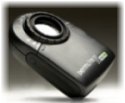Dermatoscopy
Dermatoscopy (dermoscopy, epiluminescence microscopy) in a non-invasive diagnostic method used in dermatology. The examination consists in observation the lesions of the skin, using a dermatoscope. It is a microscopic examination of the skin surface, which allows for the observation and assessment of pigment structures at the skin level. The dermatoscope is a special optical device with several or several of dozen magnification. Built-in side lighting (it illuminates observed surface), it allows getting a “three-dimensional image” of the skin (it reveals the deeper structure of the observed change). Dermatoscopy is an indirect examination between the clinical assessment (“unprotected eye”) and histopathological examination of the excised lesion.
Assessment of changes is based on the observation of external features, including asymmetry, delimitation, diversity of colors and typical structures, invisible to the naked eye:
- the presence of the mesh
- areas with a blurred structure
- bandwidth
- dots and globules
- abnormal vascularity
The dermatoscope examination can be repeated many times. It is performed with patients of all ages as well as in pregnant women. It is mainly used for the evaluation of pigmentary changes, as melanocytic changes (pigment staining, melanoma) and non-melanocytic (vascular, keratinocyte). The task of dermatoscopy is first of all to distinguish pigmentary changes from non-pigmented ones, and in the case of pigmentary changes, to monitor them and possible early detection of neoplastic transformation.
By means of a dermatoscope, there is a possibility to identify changes such as:
- malignant melanoma,
- epithelioid cell nevus-Reed,
- melanocytic nevus,
- blue nevus,
- seborrhoeic wart,
- angioma(lymphoblastoma),
- epithelioma,
- hermorrhagic changes
A dermatoscopic examination should be performed for each lesion, which:
- it has just appeared,
- it grows really fast,
- it flakes off,
- it itches,
- it is bleeding,
- it has irregular edges,
- it has patchy color,
- it is changing fast
Other mark’s features, that we should pay attention to, are:
- oozing of the marks, ,
- redness around the birthmark,
- swelling and pain.
Essential information before the treatment:
1. Medical history of family (occurrence of skin cancer in the family),
2. Existing course of the disease (time of appearance of the lesion, speed of enlargement, change of color, shape, pain’s occurrence, itching, bleeding, ulcerating, crusts, etc.),
3. History of treatment (eternal preparations, surgical treatment –e.g. mechanical extrusion, freezing);
 Dermatoscopy does not provide a definitive diagnosis. However, it allows to differentiate between the benign changes and atypical changes. It defines the way of further proceeding clearly and specifically.
Dermatoscopy does not provide a definitive diagnosis. However, it allows to differentiate between the benign changes and atypical changes. It defines the way of further proceeding clearly and specifically.
The advantages of dermatoscopy:
a) it is safe,
b) it is painless,
c) there is a possibility of multiple repetitions (it is recommended to many marks occurred),
d) there is no age limit,
e) it can be performed to pregnant women;
Special situations requiring dermatoscopic assessment:
- appearance of new pigment changes on the skin,
- evolution of the older marks: shape’s change, size’s change, color’s change, consistency’s change, appearance of itching, pain, bleeding etc.,
- possibility of frequently irritated, hooked and injured marks (clothing adjoining areas, shaved or depilated area),
- marks, located in open spots (frequent exposure to ultraviolet radiation);
Dermatoscopic assessment of skin lesions requires sustained experience. If the doctor has some doubts recording the dermatoscopic assessment, the skin change is surgically cut and then, it is examined histopathologically.

